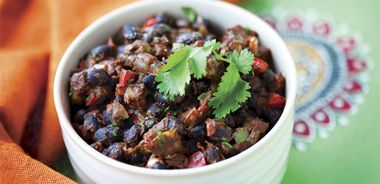Cocoa Black Bean Taco Filling

2 tsp (10 mL) grapeseed or other oil of choice
1 small yellow onion, diced
1 red bell pepper, diced
2 tomatoes, diced
1 ripe plantain (yellow peel with some black spots), peeled and diced (optional)
1 jalapeno pepper, seeded and diced
1 - 19 oz (540 mL) can black beans, rinsed and drained
2 Tbsp (30 mL) cocoa powder
1/2 tsp (2 mL) cumin powder
1/4 tsp (1 mL) sea salt
1/4 tsp (1 mL) black pepper
1/3 cup (80 mL) cilantro, chopped
Juice of 1/2 lime
Heat oil in skillet over medium heat. Add onion and cook for 2 minutes. Add bell pepper and cook for 2 minutes more. Add tomatoes, plantain (if using), jalapeno pepper, black beans, cocoa powder, cumin, salt, and pepper to skillet and cook for 2 minutes. Stir in cilantro and lime juice and remove from heat.
Serves 8.
Each serving contains: 116 calories; 5 g protein; 2 g total fat (0 g sat. fat, 0 g trans fat); 22 g total carbohydrates (5 g sugars, 6 g fibre); 332 mg sodium
source: "Taco Party", alive #376, May 2013





